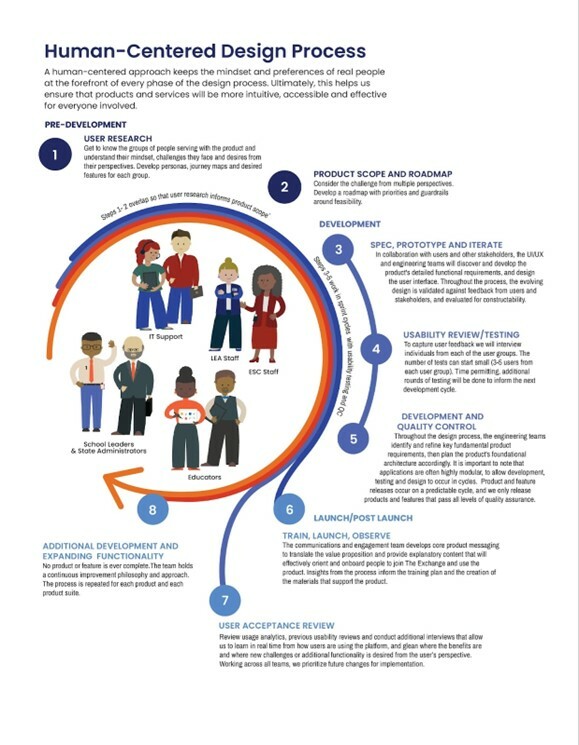Written by: Mikhaila Moynihan
Human-Centered Design (HCD) is an approach to product development that prioritizes the needs of teachers, administrators, and educators at all levels and in all roles. It often follows the design thinking process, which recommends building products by empathizing with end-users ahead of product development; defining major pain points users experience; ideating based on end-user feedback; gathering feedback on prototypes; testing products in the final development phase; and finally, launching. After launch, the process continues by collecting and prioritizing feedback from actual users. Then the design process begins again to improve the product through future releases.
HCD is a foundational approach in most modern-day software companies. Without it, organizations take on great risk sinking resources into products that may not serve people’s needs, which then eventually fail. The Texas Education Exchange (The Exchange) believes HCD is a necessary process to follow as it centers educators in our work, increases the likelihood that the public dollars invested into the platform will lead to useful (and even delightful) products, and supports continuous improvement.
So, how is The Exchange ensuring HCD guides our product development? Our current approach is threefold:
1) We select partners who understand and emphasize the importance of HCD in their work. Many have developed their own frameworks and assets based on their individual approach.
2) Beyond selecting partners who are champions of HCD, we built HCD requirements into our contracts. The Exchange has developed a checklist of contract deliverables influenced by the design thinking process. This ensures all partners develop and design based on the input of educators, regardless of their experience with user research.
3) We ensure third-party application providers are collecting end-user feedback and are adequately integrating it into their development roadmap. When vetting and prioritizing tools to be offered through The Exchange, we collect information on providers’ approach to HCD and their ability to collect and respond to end-user input.
If, after learning about The Exchange’s commitment to HCD, you would like to contribute your voice and expertise to our research, please reach out to jennifer.duncan@esc4.net. We want to ensure the wisdom of all Texas educators is incorporated into our work.

For more information on human-centered design, refer to these resources:
Why Design Thinking Works, Harvard Business Review
Design Thinking Explained, MIT Management Sloan School
Introduction to Design Thinking, IDEO Design Thinking
